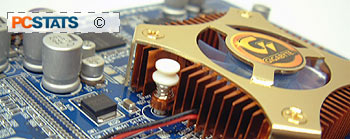 The
heatsink on the Gigabyte GV-R96X128D's ATI 'RV360' VPU is a bit on
the small side compared to the monsters used with current Nvidia cards. Since
the Radeon 9600XT core is built with 0.13 micron manufacturing technology, less heat is
produced because individual transistors are smaller.
The
heatsink on the Gigabyte GV-R96X128D's ATI 'RV360' VPU is a bit on
the small side compared to the monsters used with current Nvidia cards. Since
the Radeon 9600XT core is built with 0.13 micron manufacturing technology, less heat is
produced because individual transistors are smaller.
Unlike the more expensive Radeon VPUs, the 9600XT core is actually
not protected with a metal shim around the edge of the FCPGA
chip. If you're planning to install a larger third party heatsink like the Zalman
HP-80A this is good news. Remember to be careful otherwise you could chip a corner
off the brittle silicon core however.
Those of you with case windows should like the deep blue glow given off by
the Gigabyte GV-R96X128D's fan. The fan is pretty much silent under power, and that
is certainly an advantage of most Nvidia graphics cards on the store shelves these days.
If you have an older
PC, please keep in mind that while this is a mainstream videocard, the Gigabyte GV-R96X128D is
not 2x AGP compatible! There's no 2x AGP key, and
any attempt to make it fit will probably just result in a fried motherboard once
you turn the system on.
How about a little Overclocking on the
side?
Despite the
0.13 micron manufacturing process the core is built with, the Radeon 9600XT VPU didn't seem to have
much in the way of headroom. Starting at 500 MHz we slowly raised the core speed of the
Gigabyte GV-R96X128D a few MHz at a time. To my surprise the RV360 core seemed to have a
lot of legroom as it passed 550 MHz very easily. In the end it ran
602 MHz
with the stock cooler. Now that is quite a feat!
The
128MB of DDR memory on the Gigabyte GV-R96X128D are based on the same 2.8ns
Samsung DRAMs we find on other Radeon 9700 Pro/9800 Pro videocards, but for some
reason I was expecting more conservative results from them. Starting at 200 MHz
the memory overclocked to a mere 327 MHz.
Unlike most other ATi based videocards we've
tested, the Gigabyte GV-R96X128D's core and memory did not play nicely together.
In order to run both the core and memory overclocked we had to
lower the core speed
to 587 MHz.
 |
| PCStats Test System Specs: |
| processor: |
intel pentium 4 3.0c |
| clock
speed: |
15 x 200 mhz = 3.0 ghz |
| motherboards: |
gigabyte 8knxp, i875p |
| videocard: |
ati radeon 9800 pro
ati radeon 9700 pro
gigabyte
radeon 9600 pro
msi fx5900u-vtd256
albatron geforcefx 5600
ultra (rev2)
msi g4ti4600-vt2d8x
gigabyte
gv-r96x128d |
| memory: |
2x 256mb corsair twinx 3200ll |
| hard
drive: |
40gb wd special ed |
| cdrom: |
nec 52x cd-rom |
| powersupply: |
vantec stealth 470w |
| software
setup |
windowsxp build 2600
intel inf 5.03
catalyst
3.9
detonator 52.16 |
| workstation
benchmarks |
3dmark2001se
3dmark03
aquamark
aquamark3
codecreatures
gun
metal 2
quake iii arena ver 1.17
ut2003
aa test, af and aa+af test
3dmark2001se
quake iii arena | |
